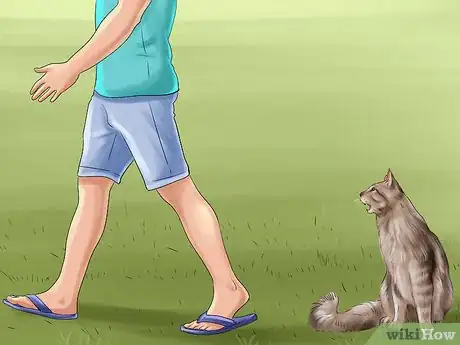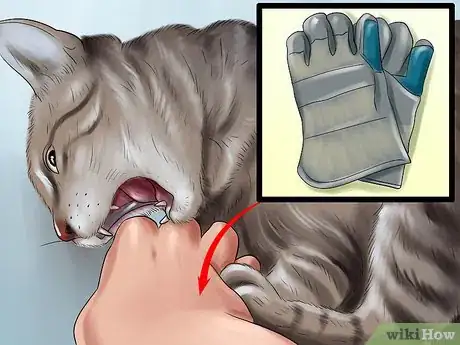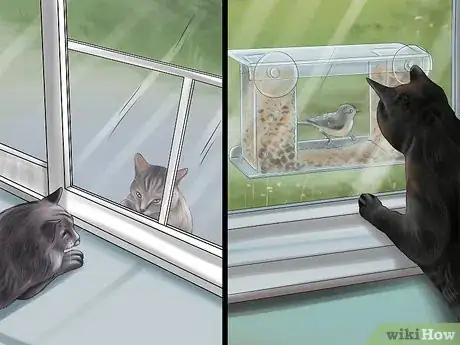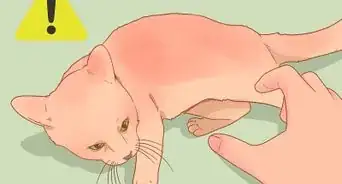This article was co-authored by Ryan Corrigan, LVT, VTS-EVN. Ryan Corrigan is a Licensed Veterinary Technician in California. She received her Bachelor of Science in Veterinary Technology from Purdue University in 2010. She is also a Member of the Academy of Equine Veterinary Nursing Technicians since 2011.
This article has been viewed 19,809 times.
Redirected aggression occurs when a cat is upset about something and then turns its anger elsewhere, because it is unable to direct it at the actual event. This usually happens when an indoor cat sees something outside it wants to chase or fight, but it can’t get to the object (or animal) outside. Therefore, if the cat is startled or interrupted by someone or something it can’t reach, the cat may instinctively react in an aggressive way. If your cat is redirecting its aggression at you, there are a few things you can do to help.
Steps
Dealing With Redirected Aggression
-
1Walk away. Redirected aggression is an involuntary reflex. Your cat doesn’t mean to make you the target of its aggressive outburst; the cat simply reacts to how its body feels. If your cat is showing signs of aggression toward you for seemingly no reason, consider just walking away and giving your cat a chance to calm down.[1]
- Leaving your cat alone to get over the feelings of aggression is the best bet to ensure that there is no unintended altercation between you and your pet.
- You should also try to segregate the cat from any other pets or humans in the house.
-
2Interrupt the observation. If your cat is staring out the window with incredible intensity, you may want to try to break the spell. Give your cat a quick spray of water, clap your hands loudly, or make a loud sound to startle the cat.[2]
- This should hopefully cause your cat to stop paying attention to whatever it is that is agitating it and give the cat an opportunity to calm down.
- If you use water, keep a spray bottle readily available.
Advertisement -
3Make safety your top priority. Remember that when you’re dealing with an aggressive cat, it’s possible that you may get injured. The cat may bite you or claw you in its redirected aggressive outburst.[3]
- If you have to engage with an aggressive cat, take the proper safety precautions. Wear thick gloves if possible or several layers of clothing.
- Try to avoid separating your cat from another animal if it is behaving aggressively. But if you must interfere, be extremely careful and be cautious of bites and scratches. Try using a squirt bottle or pillow to break up a fight between cats.
- Remember that it is possible for the cat to injure itself also. Try to control the cat’s behavior without provoking it to react in a way that is more harmful to itself.
- If you do get bit or scratched by a cat, go to a doctor right away to have it treated and looked at. Even if it seems superficial and not serious, cats’ mouths have lots of bacteria and can cause very severe infections that can become systemic if not treated.
Preventing Trigger Situations
-
1Limit the cat’s view outdoors. If your cat is an indoor-only cat, consider limiting how much access your cat has to viewing the outside world. Your cat is responding with aggression to things that it sees outside, but taking it out on you. You can minimize this problem by removing the temptation of the things the cat feels aggressive toward outside.[4]
- Try covering the windows with blinds or curtains, preferably ones your cat can’t simply push out of the way.
- Remember to leave the door closed so that your cat can’t constantly look out of the screen. Additionally, you can try closing the doors to rooms that provide views of the outdoors.
-
2Separate cats that fight often. If you have more than one cat in your home and one (or more) of them seems to initiate fights and engage in aggressive behavior often, you may want to consider separating them.
- After the cats have been separated for a while (at least a few days), start introducing them to one another again slowly.
- Start with a smell introduction, where you bring in something that smells like the other cat. Then move toward a short face-to-face encounter.
- Keep lengthening the amount of time you keep the cats together until you think they’re ready to be around each other full time again.
-
3Avoid bringing in scents of other animals. Sometimes cats redirect aggressive behavior towards their owners if they catch a whiff of an unfamiliar animal on their human. If your cat is acting aggressively, try to limit your contact with other animals outside the home.
- If you must engage with other animals, try to wash your hands or change clothing before you see your cat at home.
Understanding Redirected Aggression
-
1Know that it isn’t directed at you. Recognize the fact that the aggressive behavior isn’t really directed at you. This kind of outburst is an instinctual, involuntary reaction that your cat is having to other external factors. Sometimes, if the cat can’t get to the thing causing the aggressive feelings, it will lash out at the next thing it encounters.[5]
- This doesn’t indicate that your cat is mean, doesn’t like you, or that you have a bad relationship with your cat.
-
2Speak to an animal behaviorist if your cat continues to be aggressive. If you are still having trouble understanding your cat’s aggressive behavior, find a board certified animal behaviorist to help you understand and work through your cat's behavior. This person can provide additional guidance and techniques you can use to help your cat.
- Start by talking to your cat’s veterinarian, who may be able to offer a referral. Otherwise, search for an animal behaviorist in your area.
-
3Watch for signs of aggression. If you know what to look for, the signs of aggression can be pretty obvious in cats. They typically either make themselves larger in an overtly aggressive manner, or they try to make themselves appear smaller in a defensively aggressive situation. Some standard signs of aggressive behavior in cats include:[6]
- Growling, howling, hissing, or spitting.
- Stiff tail lowered to the ground.
- Crouching.
- Flattened ears.
- Turning sideways instead of facing the opponent straight on.
-
4Monitor potential triggers. There are quite a few situations that commonly cause cats to redirect their anger. In these situations, the cat is unable to reach or interact with the object of its aggression, so it transfers these feelings and instincts to something in its environment. Some examples of situations that can cause redirected anger in cats include:[7]
- Seeing another cat outside through the window.
- Smelling a strange cat’s odor on a family member.
- Watching birds or other prey animals.
- Being in an animal shelter or veterinarian’s office.
- Hearing high-pitched noises.
References
- ↑ https://icatcare.org/advice/problem-behaviour/aggression-humans
- ↑ http://www.humanesociety.org/animals/cats/tips/aggression_toward_people.html
- ↑ http://www.catster.com/lifestyle/cat-behavior-tips-redirected-aggression-in-cats
- ↑ http://www.catster.com/lifestyle/cat-behavior-tips-redirected-aggression-in-cats
- ↑ http://jacksongalaxy.com/blog/2014/08/21/aggression-in-cats
- ↑ http://www.aspca.org/pet-care/cat-care/common-cat-behavior-issues/aggression-cats
- ↑ http://www.aspca.org/pet-care/cat-care/common-cat-behavior-issues/aggression-cats
About This Article
To respond to redirected aggression in cats, walk away whenever your cat is being aggressive to minimize chances of an altercation. If your cat is staring intensely out of the window and seems stressed or aggressive, try clapping your hands or making a loud sound to redirect its attention. You should also bear in mind that you’re dealing with an aggressive cat, so only engage with it if absolutely necessary. Alternatively, If you do have to intervene, try and wear thick gloves and clothing to protect yourself from biting or clawing. For more tips from our Veterinary co-author, including how to minimize triggers for your cat’s aggression, read on!


































































